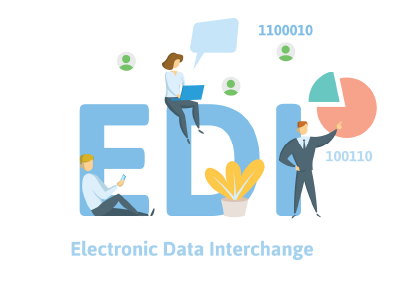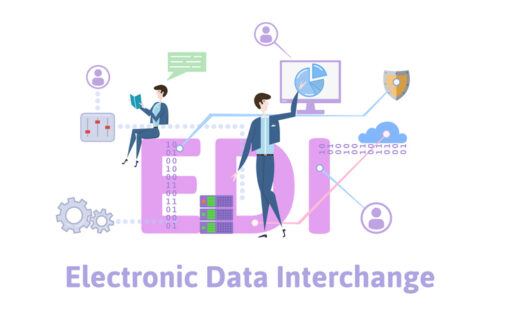What is EDI?
Your Guide to Electronic Data Interchange
In today’s rapidly evolving business landscape, efficient and streamlined communication between organisations is vital. Electronic Data Interchange (EDI) is a powerful tool that facilitates this seamless exchange of business documents and information between different parties.
The History of EDI
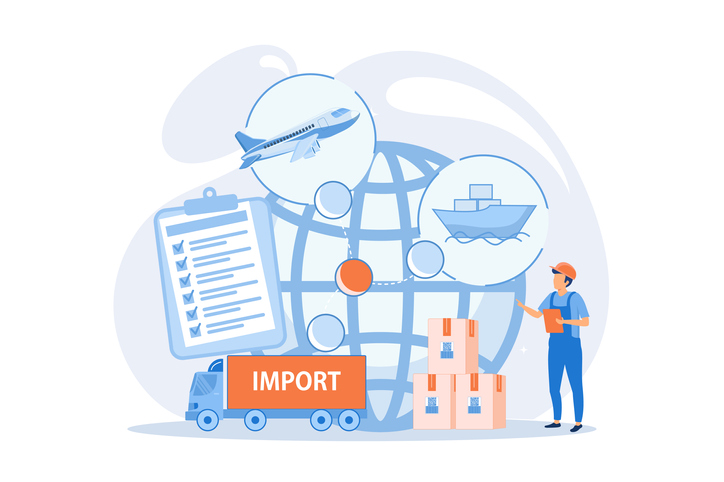
1960s
The earliest experiments of EDI can be traced back to the 1960s when a prototype EDI system was created by U.S. Army Master Sargent. Edward Guilbert to control shipments for the army supply chains. This initial method was built for use on more advanced computers so wasn’t initially easily accessible.

1970s
In 1971, Heathrow Airport implemented a similar strategy into a freight control system called the London Airport Cargo EDP Scheme (LACES). The FTP communication protocol was first published (File Transfer Protocol) in 1973. The transportation industry released the first EDI standard in 1975 (referred to as the TDCC standard).

1980s
In 1981 the ANSI X12 EDI standard was published and implemented across various industries including retail and banking. The following year, the standard was republished to be able to support use across industries. Major trading partners mandating the use of EDI with their suppliers became noticeable within the retail and automotive industries in 1982.

1990s
The 90s saw the adoption of EDI become more widely accepted and the exchange of EDI documents move across the internet.

2000s
An XML-based approach to EDI was developed along with more affordable solutions for small and medium-sized businesses. The AS2 communications protocol is also published.

Present
EDI continues to grow with some of the largest companies across the globe using it to streamline their supply chain and create greater visibility and efficiency throughout.
Understanding EDI
Electronic Data Interchange (EDI) is the structured, standardised electronic exchange of business data between organisations. It replaces traditional paper-based communication with a digital approach, allowing for a significantly reduced timescale in the transmission of various business documents like purchase orders, invoices, shipping notices, and more in a predefined format.
Any organisation that engages in the transmission of business documents, regardless of their industry, can benefit immensely from implementing EDI. Whether you’re in retail, healthcare, manufacturing, or any other sector, if your business involves the exchange of purchase orders, invoices, shipping notices, and the like, EDI becomes a valuable asset. Its versatility lies in its ability to adapt to various document types and industry-specific standards, ensuring seamless communication between partners, suppliers, and customers.
Understanding EDI Standards & EDI Message Types
EDI standards are predefined formats and rules that dictate how electronic documents should be structured and exchanged. These standards ensure consistency and uniformity, enabling seamless communication and data interpretation across various businesses and industries. Examples of widely used EDI standards include EDIFACT, Tradacomsl, ASC X12, VDA and SWIFT.
EDIFACT
EDIFACT stands for Electronic Data Interchange for Administration, Commerce and Transport and was created in 1987. EDIFACT provides a collaborative platform facilitating the exchange of diverse EDI message types, offering businesses an effective means of communication with their trading partners. It’s worth noting that esteemed retailers like Lidl, Sainsbury’s, and Morrisons have made the strategic choice of embracing EDIFACT as their favoured EDI standard.
Some of the most common messages under EDIFACT:
- ORDERS – Purchase Order
- ORDRSP – Purchase Order Response
- ORDCHG – Purchase Order Change Request
- INVRPT – Inventory Report
- REMADV – Remittance Advice
- CREADV – Credit Advice
For more information, why not check out our ‘What is EDIFACT?’ article?
Tradacoms
Tradacoms stands for Trading Data Communication Standard and is most commonly associated with the UK retail industry. While it was developed slightly earlier than the EDIFACT standard, major trading partner like Boots and Superdrug still opt for this option.
Common message types we see under Tradacoms:
- ORDHDR – Order
- NVFIL – Invoice
- CREHDR – Credit Note
- DELHDR – Delivery Notification
For more information, why not check out our ‘What is Tradacoms?’ article?
ASC X12
The ASC X12 EDI standard is a widely adopted set of protocols and formats that govern the electronic exchange of business documents in North America. ASC X12 defines the structure and standards for various types of EDI transactions, ensuring consistency and compatibility among different businesses and industries, ultimately enabling seamless electronic communication and data exchange.
Some of the message types we see under ASC X12:
- 850 – Purchase Order
- 820 – Invoice
- 846 – Inventory Status
- 856 – Advanced Shipping Notice (ASN)
For more information, why not check out our ‘What is ASC X12?’ article?
How EDI Works
Without EDI, a typical manual procure-to-pay process would heavily involve a hands-on approach, becoming very resource-intensive and prone to human errors. Though once a conventional and widely utilised approach, it carries inherent challenges and drawbacks that hinder operational efficiency and cost-effectiveness for organisations.
Including:
- Time-consuming due to the need for physical paperwork and manual approvals, delaying your procurement cycle and impacting your business’ agility.
- Limited visibility and ability to easily track the status of your orders, hindering decision-making and causing delays in resolution time frames.
- Lack of scalability as your business and volume of transactions grow.
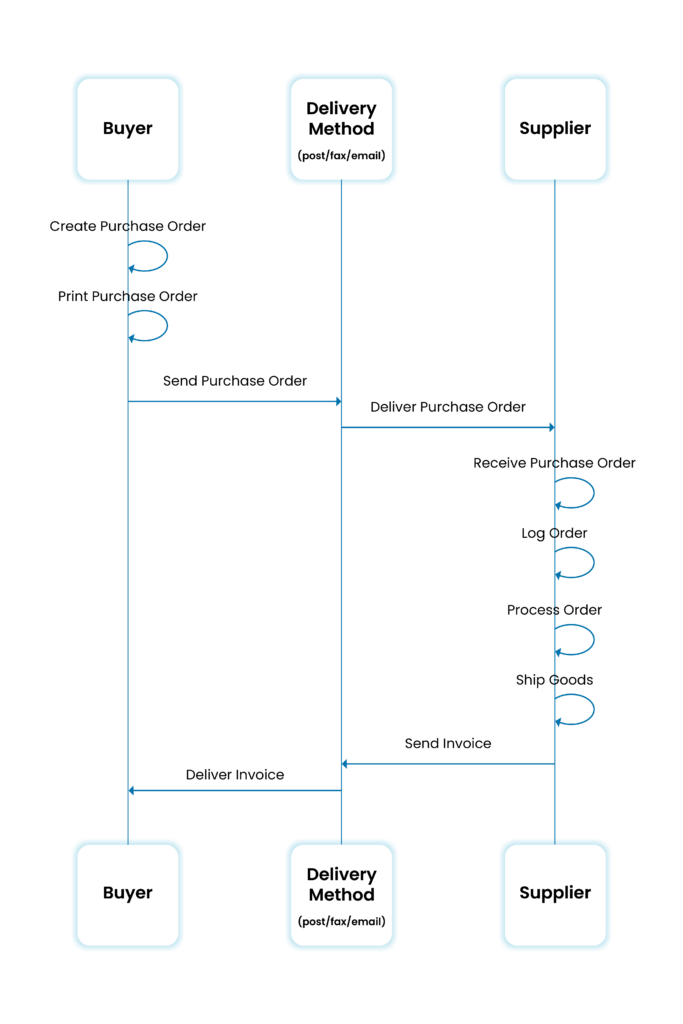
At its core, EDI works by translating business documents into a standardised electronic format. This format, typically based on industry-specific standards like ASC X12, EDIFACT, Tradacoms, or XML, allows different computer systems to understand and process the information contained in the documents.
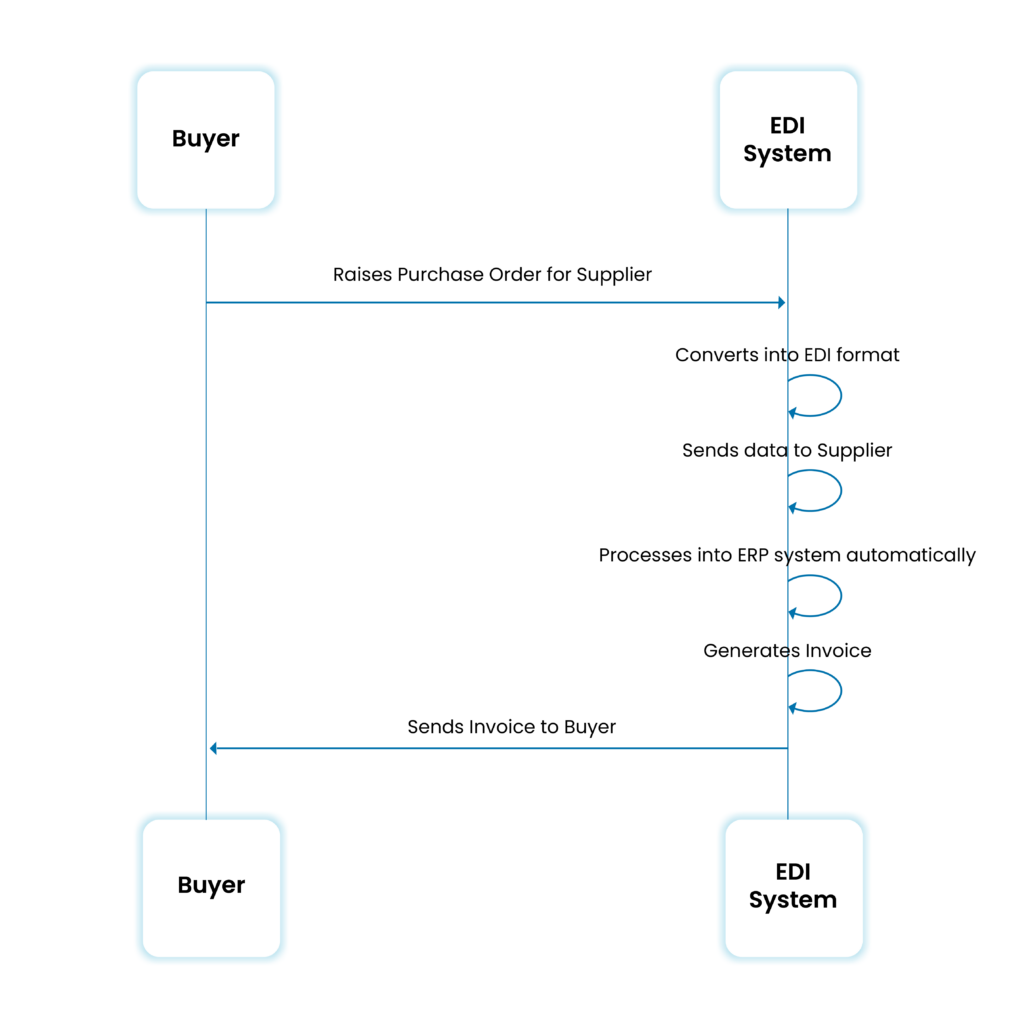
The process involves the following steps:
Document Creation: A business creates a business document (e.g., a purchase order) in its internal system.
Translation: An EDI translator software or service translates this document into the agreed-upon EDI standard format.
Transmission: The translated EDI document is transmitted securely to the intended recipient via a designated communication protocol, such as a Value-Added Network (VAN), AS2, FTP, or through a direct connection.
Reception and Translation: The recipient’s system receives the EDI document and translates it back into a format compatible with its internal systems.
Integration: The received document is integrated into the recipient’s internal systems for further processing and action.
There have been a number of studies across various industries exploring the benefits of implementing EDI, specifically around cost savings and speed. In 2010, GS1 prepared a report on electronic transactions in the supply chain and found that “what previously took up to 5 days, now takes a few minutes”. Technology has improved in the time since the report so if you’re not already utilising EDI you could be saving even more time and money.
Benefits of EDI
Cost Savings
By moving to digital you eliminate paper-based transactions, printing and postage costs, as well as the costs associated with personnel, supplies and storage. The study from GS1 delved into the cost savings EDI can provide, including a detailed breakdown of how much you could save per order, invoice and despatch advice in comparison to their manual process counterpart. GS1 found that using EDI will save you £14 per order. This may not blow your mind but when put in a wider context, GS1 found that by using electronic order messages for 87% of its purchase orders, the UK grocery sector saved £332 million in 2009.
Enhanced Efficiency from Reduced Errors
EDI automates manual processes, reducing the time and effort required to handle transactions. Eliminating the need for manual data entry significantly reduces the likelihood of errors that can occur during traditional data handling. This enhances data accuracy and improves efficiency, leading to quicker order processing, fewer delays, and improved overall productivity.
Shorter Business Cycles
In traditional trading practices relying on manual methods, the delivery of critical documents can be a lengthy process, sometimes taking several days via postal services. Moreover, there’s the risk of the document being lost or containing errors, which may go unnoticed for weeks. Even with the use of fax machines, documents can sit idle before necessary actions are initiated. EDI enables real-time document exchange, significantly speeding up business cycles to a matter of minutes. Consequently, this efficiency translates to expedited payments, significantly improving your cash flow. EDI’s real-time capabilities present a substantial enhancement for businesses seeking agility and promptness in their trading operations.
Enhanced Customer and Partner Relationships
The benefits achieved through the implementation of EDI can trigger a ripple effect, positively impacting multiple facets of a business’s operations. Efficient and accurate transactions, facilitated by EDI, contribute to improved customer satisfaction and stronger business relationships with partners. Your supply chain will gain a better understanding of the exchanged information, fostering more productive relationships.
The Future of EDI
EDI continues to evolve with advancements in technology. Some key trends shaping the future of EDI include:
- Integration with AI and Machine Learning
Leveraging AI and machine learning can enhance data analysis, pattern recognition, and predictive capabilities within EDI, leading to smarter decision-making and process optimisation. Through this, AI-powered systems could also automate the complex process of transforming and mapping diverse data formats, allowing for quicker, more accurate, and adaptable data translations.
- Blockchain Integration
The integration of blockchain technology is a potent solution, establishing an unalterable record of transactions. This technology holds the potential to optimise business operations, bolster security, and fortify trust among stakeholders. By eliminating intermediaries, it effectively trims costs while expediting and ensuring the precision of transactions.
- Cloud-Based EDI Solutions
While this was once seen as the future of EDI too, it is now considered best practice.
In conclusion, Electronic Data Interchange (EDI) streamlines business communication by automating the exchange of crucial business information in a standardised, digital format. The benefits of EDI are numerous, including improved efficiency, cost savings, and better accuracy. As technology advances, the future of EDI holds exciting potential with integration into emerging technologies like AI, and blockchain, ensuring a continued and significant impact on modern business operations.
Want to know more about EDI? Check these out...
See allWant to know more?
Speak to an expert today
Enter your details below or call us on +44 (0) 1772 977781


